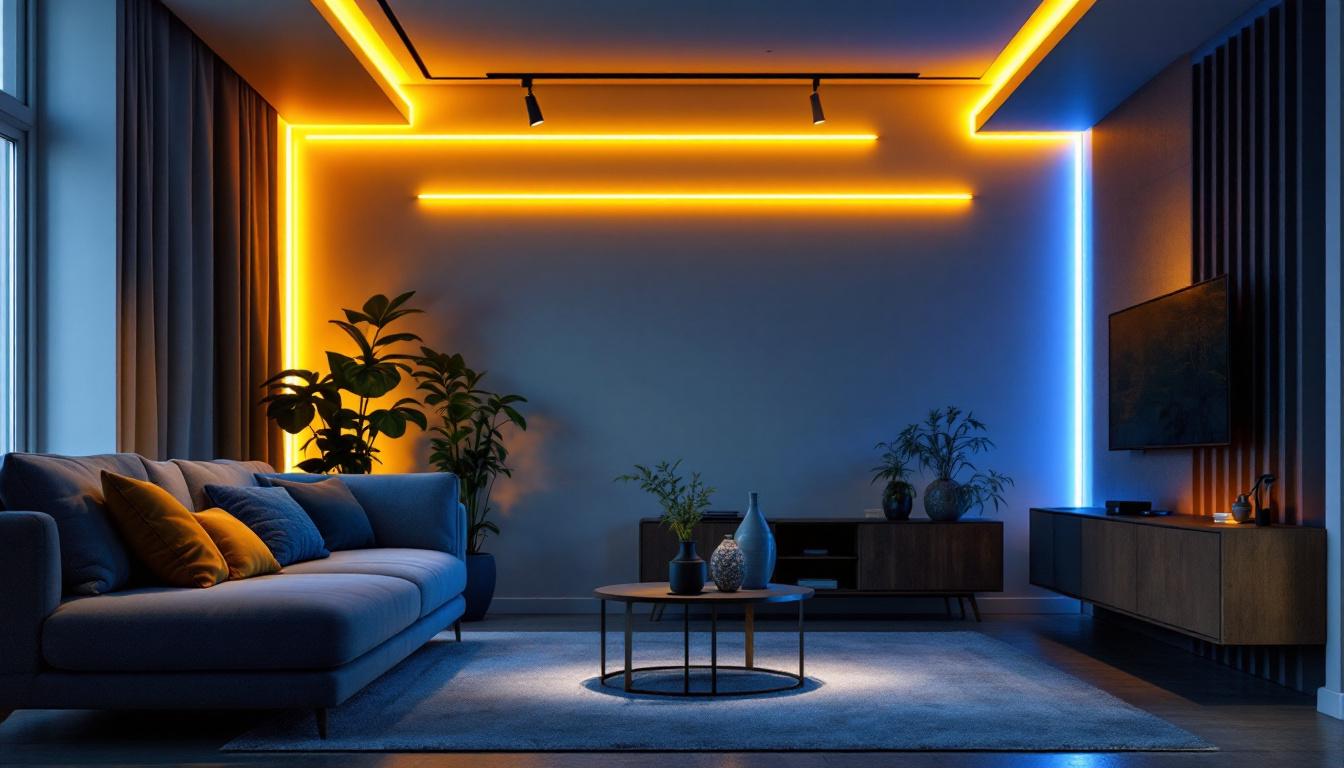In the ever-evolving world of lighting design, LED background lights have emerged as a revolutionary tool for lighting contractors. These innovative lighting solutions not only enhance aesthetics but also offer practical benefits that can significantly impact project outcomes. As the demand for energy-efficient and versatile lighting solutions continues to grow, understanding the advantages of LED background lights becomes essential for professionals in the field.
LED technology has transformed the lighting industry over the past few decades. Initially, LEDs were primarily used in small applications like indicators and displays. However, advancements in technology have expanded their use into general lighting, including background lighting. This shift has opened new avenues for creativity and functionality in lighting design. The versatility of LEDs allows designers to experiment with various colors, intensities, and patterns, enabling them to create dynamic environments that can change the mood of a space with just the touch of a button.
One of the most compelling advantages of LED background lights is their energy efficiency. Compared to traditional incandescent or fluorescent lights, LEDs consume significantly less power while providing the same level of brightness. This not only reduces electricity costs but also minimizes the environmental impact, making them a preferred choice for eco-conscious clients. Moreover, the low heat emission of LEDs contributes to their efficiency; less energy wasted as heat means more light output per watt consumed. This characteristic is particularly beneficial in commercial settings where lighting is used extensively, as it can lead to substantial savings on cooling costs as well.
LEDs boast an impressive lifespan, often lasting up to 25 times longer than traditional bulbs. This durability translates to fewer replacements and lower maintenance costs for lighting contractors. Projects that utilize LED background lights can benefit from reduced downtime and increased client satisfaction, as the need for frequent bulb changes is virtually eliminated. Additionally, the robust construction of LEDs makes them resistant to shocks and vibrations, which is especially valuable in environments like warehouses or outdoor installations where traditional bulbs might fail prematurely. This resilience not only enhances the reliability of lighting solutions but also supports sustainable practices by reducing waste associated with discarded bulbs.
Furthermore, the adaptability of LED technology allows for innovative applications beyond mere illumination. For instance, smart LED systems can be integrated with home automation technologies, enabling users to control their lighting through mobile apps or voice commands. This integration not only offers convenience but also allows for personalized lighting experiences tailored to individual preferences. As the Internet of Things (IoT) continues to evolve, the potential for LED technology to contribute to smart cities and energy-efficient buildings becomes increasingly significant, paving the way for a more interconnected and sustainable future.
LED background lights offer unparalleled design flexibility, allowing lighting contractors to create unique and captivating environments. The compact size and versatility of LEDs enable their integration into various settings, from residential homes to commercial spaces and outdoor installations. This adaptability means that whether you’re illuminating a cozy living room or an expansive retail store, LED lights can be tailored to fit the specific requirements of the space, enhancing both functionality and aesthetics.
Moreover, the lightweight nature of LED fixtures makes them easy to install in unconventional locations, such as under cabinets, along staircases, or even embedded in furniture. This opens up a world of creative possibilities for designers and architects, enabling them to push the boundaries of traditional lighting design and explore innovative concepts that were previously difficult to achieve with conventional lighting sources.
One of the standout features of LED background lights is the wide range of color options available. With the ability to produce millions of colors and dynamic lighting effects, contractors can tailor lighting schemes to suit specific themes or moods. This capability is particularly advantageous in settings such as restaurants, theaters, and event spaces, where ambiance plays a crucial role in the overall experience. For instance, a restaurant may choose warm hues to create an intimate dining atmosphere, while a theater can utilize vibrant colors to enhance the visual impact of a performance.
Additionally, the use of color-changing LEDs allows for seamless transitions between different lighting states, enabling venues to shift from a lively, energetic vibe to a more subdued, relaxing atmosphere with just the touch of a button. This adaptability not only caters to the immediate needs of the space but also allows for seasonal or event-based changes, keeping the environment fresh and engaging for repeat visitors.
As the smart home trend continues to gain traction, integrating LED background lights with smart technology has become increasingly popular. Lighting contractors can now offer clients the ability to control their lighting remotely via smartphones or voice-activated devices. This integration not only enhances convenience but also allows for customizable lighting scenarios that can adapt to various activities and preferences. Homeowners can program their lights to gradually brighten in the morning, creating a gentle wake-up experience, or set the mood for movie nights with dimmed, colored lighting that enhances the cinematic experience.
Furthermore, smart lighting systems often come equipped with features such as scheduling and automation, allowing users to set their lights to turn on or off at specific times or in response to certain triggers, like entering a room. This level of control not only contributes to energy efficiency but also provides an added layer of security, as homeowners can simulate occupancy while away by programming their lights to mimic their usual patterns. As technology continues to evolve, the possibilities for smart LED lighting integration are expanding, making it an exciting area for both contractors and consumers alike.
While the initial investment in LED background lights may be higher than traditional lighting options, the long-term savings are substantial. The combination of energy efficiency, longevity, and reduced maintenance costs contributes to a lower total cost of ownership. For lighting contractors, this means the ability to present clients with a solution that is not only aesthetically pleasing but also financially advantageous.
Clients are increasingly aware of the financial implications of their lighting choices. By opting for LED background lights, they can enjoy significant savings on energy bills and maintenance costs. This return on investment can be a compelling selling point for lighting contractors, positioning them as knowledgeable professionals who prioritize both aesthetics and practicality.
Many regions offer incentives or rebates for the installation of energy-efficient lighting solutions, including LEDs. Lighting contractors can assist clients in navigating these programs, further enhancing the value proposition of LED background lights. By highlighting potential savings through rebates, contractors can make a strong case for the switch to LED technology.
While the benefits of LED background lights are clear, proper installation is crucial to maximizing their effectiveness. Lighting contractors must be well-versed in the unique requirements and best practices associated with LED installations.
LEDs operate differently from traditional lighting sources, particularly regarding voltage and current. Contractors must ensure that the power supply is compatible with the LED fixtures being used. This may involve selecting appropriate drivers or transformers to prevent flickering or premature failure of the lights.
Effective placement and spacing of LED background lights can greatly influence the overall impact of the lighting design. Contractors should consider factors such as the height of ceilings, the purpose of the space, and the desired lighting effect when determining the layout. Proper planning can help achieve a balanced and visually appealing result.
The versatility of LED background lights makes them suitable for a wide range of applications. Understanding the various environments where these lights can be utilized allows lighting contractors to expand their service offerings and cater to diverse client needs.
In residential settings, LED background lights can enhance the atmosphere of living rooms, bedrooms, and outdoor areas. They can be used to create accent lighting, highlight architectural features, or provide ambient light for relaxation. Homeowners are increasingly seeking personalized lighting solutions, and contractors can leverage this trend by offering tailored LED installations.
For commercial spaces, LED background lights can significantly influence customer experience. Retail stores, restaurants, and offices can benefit from well-designed lighting that promotes brand identity and enhances functionality. Contractors can work with business owners to create lighting schemes that not only attract customers but also improve employee productivity.
In event spaces and theaters, the ability to change colors and effects on demand is invaluable. LED background lights can be programmed to create stunning visual displays that enhance performances and events. Lighting contractors can collaborate with event planners to design dynamic lighting solutions that leave a lasting impression on attendees.
While the advantages of LED background lights are numerous, there are challenges that lighting contractors may encounter during installation and implementation. Being aware of these challenges and having strategies to address them is essential for success.
Although LEDs are more efficient than traditional lighting, they still generate heat. Proper heat management is crucial to ensure the longevity and performance of LED fixtures. Contractors should consider the placement of lights and ensure adequate ventilation to prevent overheating, which can lead to reduced lifespan and performance issues.
When retrofitting existing spaces with LED background lights, compatibility with existing electrical systems can pose challenges. Contractors must assess the current setup and make necessary adjustments to accommodate the new technology. This may include upgrading wiring, switches, or dimming systems to ensure optimal performance.
The landscape of LED background lighting is continuously evolving. Staying informed about emerging trends and technologies can help lighting contractors remain competitive and innovative in their offerings.
Human-centric lighting focuses on creating environments that support human well-being and productivity. This trend emphasizes the importance of lighting in relation to circadian rhythms and mood enhancement. Lighting contractors can explore integrating human-centric principles into their designs, utilizing LED background lights to create spaces that promote health and comfort.
As smart technology continues to advance, the integration of LED background lights with IoT (Internet of Things) systems will become increasingly prevalent. Contractors should stay abreast of developments in smart lighting solutions, enabling them to offer clients cutting-edge options that enhance convenience and control.
LED background lights represent a significant advancement in the lighting industry, offering numerous benefits for lighting contractors and their clients. From energy efficiency and design flexibility to long-term cost savings, the advantages of LED technology are compelling. As the demand for innovative and sustainable lighting solutions continues to rise, embracing LED background lights can position contractors as leaders in the field.
By understanding the unique characteristics and applications of LED background lights, lighting contractors can enhance their service offerings and meet the evolving needs of their clients. The future of lighting is bright, and those who adapt to these changes will undoubtedly thrive in a competitive market.
Ready to elevate your lighting projects with the cutting-edge LED background lights discussed in this article? Look no further than LumenWholesale for a seamless solution. We provide lighting contractors with the highest quality, spec-grade lighting products at unbeatable wholesale prices. Say goodbye to local distributor markups and hello to superior lighting that meets the highest industry standards. With free shipping on bulk orders, LumenWholesale ensures you get premium lighting at the best value — all without hidden fees or compromises. Enhance your service offerings and delight your clients by choosing the perfect blend of quality, affordability, and convenience. Wholesale Lighting at the Best Value is just a click away.

Discover how magnetic LED light strips are revolutionizing modern lighting solutions with their versatility, energy efficiency, and easy installation.

Discover how the right outdoor electric box cover can enhance safety, efficiency, and profitability for lighting contractors.

Discover why purchasing stadium lights in bulk from local distributors might not be the best choice.

Discover innovative cost-saving strategies for lighting contractors with the CFL Bulb 13W.